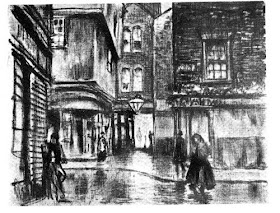The seventeenth-and eighteenth-century courts and alleys of London had mostly vanished before these drawings were made. The Kingsway and Charing Cross Road “improvement” schemes were conspicuous stages in a process of attrition which is perpetually at work. Shepherd's Market, behind Piccadilly, may serve as a surviving type of those quiet dim-lit areas which covered half Central London in Dickens's day; and there are corners in the neighbourhood of Lincoln's Inn and Fetter Lane where their atmosphere is still to be recovered. From “A London Revery. Chapter Vanishing London.” A Project Gutenberg Canada, on line.
The best known and loved herbalist is John Gerard, born in Cheshire, England (1545-1612). His “Herball” or “General Historie of Plants” first published in 1597 contains other herbalist’s flowers to be considered the greatest book on the subject, but it has remained popular for over 400 years for its collection of medical “virtues” of plants. Gerard writes of many friends whose gifts to him were rare plants and seeds from all over the world.
The Herball. From http://www.rcplondon.ac.uk/heritage/plants/History/GerardHerball_tp.jpg
John Gerard. From http://www.hsl.virginia.edu/historical/rare_books/herbalism/assets/gerard.jpg
Gerard wrote as a modest man, leaving credits for researchers as “physitions of London Colledge”. From Herball’s preface, I quote these beautiful words "Although my paines have not been spent (Curteous Reader) in the gracious discoverie of golden mines, nor in the tracing after silver veines, whereby my native country might be enriched with such merchandise as it hath most in request and admiration; yet hath my labour (I trust) been otherwise profitably employed, in descrying of such a harmlesse treasure of herbes, trees, and plants, as the earth frankely without violence offereth unto our most necessarie uses."
Herbs from Gerard’s Herball. http://www.philographikon.com/images%20botregbivortgerard/gerardbuglosse.gif
Pinetree from Gerard’s Herball. http://www.philographikon.com/imagesbotanicals/gerardmtpinetree.gif
Gerard’s Herball is more than a mere compilation. Although he stresses medicinal qualities of plants, attention is drawn to ornamental and food values, and includes extensive comments on culture and history. According to J.W. Lever (1952) there is circumstantial evidence that Gerard’s Herball may have been a source for William Shakespeare in Love’s Labour’s Lost.
His own garden was situated in what is now Fetter Lane. It must have been a beautiful garden with thousand of herbs, many of them rarities at that time. In 1596 he published a 24 page catalogue of his plants, and it was the first complete catalogue of plants in a garden.
Fetter lane, view from Holborn. http://www.arthurlloyd.co.uk/DisappearingLondon/FetterLaneHolborn.jpg
Two hundred years later, Henry Phillips described the change that had come to the neighborhood since Gerard had cultivated his garden there.
“ What would be the astonishment of this excellent old herbalist, could he be recalled, to see each avenue of his garden formed into streets; houses erected on his parsley beds, and chimneys sprung up as thick as his asparagus; churches occupying the site of his arbours, and his tool-house, perhaps, converted into the British Museum, where is safely housed the lasting memorial of his labours. In vain would he now seek wild plants in Mary-le-bone, where each blade of grass is transformed into granite, and every hawthorn hedge changed for piles of bricks: carriages rattling where sanils were formerly crawling. His ear would be assailed by the shrill cry of “Milk below”, and the deep tone of “ Old clothes”, where he had formerly retired to listen to the melody of the early lark, or the plaintive tones of the nightingale”.
REFERENCESThis post was composed with:
Jules Janick. 1987 Proc. Second National Herb Growing and Marketing Conference, Purdue Research foundation. http://www.hort.purdue.edu/newcrop/history/lecture23/r_23-2.html
Lesley Gordon. Green Magic. Chapter X. Some Herbals and Herbalists, page 66. New York.






No comments:
Post a Comment